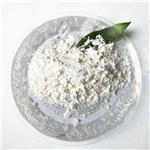- Cancidas
-

-
2025-07-12
- CAS:179463-17-3
- Min. Order:
- Purity: 0.99
- Supply Ability:
- Caspofungin acetate
-

- $0.00 / 25KG
-
2025-07-07
- CAS:179463-17-3
- Min. Order: 1KG
- Purity: 99%
- Supply Ability: 50000KG/month
- Caspofungin Acetate
-

- $52.00 / 5mg
-
2025-07-01
- CAS:179463-17-3
- Min. Order:
- Purity: 99.9%
- Supply Ability: 10g
|
| | Caspofungin acetate Basic information |
| | Caspofungin acetate Chemical Properties |
| Melting point | >105°C (dec.) | | storage temp. | -20°C | | solubility | H2O: soluble15mg/mL (clear solution) | | form | powder | | color | white to beige | | Water Solubility | H2O: 15mg/mL (clear solution) | | InChIKey | OGUJBRYAAJYXQP-LLXMLGLCSA-N |
| WGK Germany | 3 | | RTECS | TP8046500 |
| | Caspofungin acetate Usage And Synthesis |
| Description | Caspofungin is the first in a new class of antifungal agents named echinocandin to be
launched in the US for the parenteral treatment of invasive aspergillosis in patients
refractory to, or intolerant of other antifungal therapies such as amphotericin-B1 lipid
formulation of amphotericin-B and/or itraconazole. Caspofungin is a water soluble, stable,
aza-substituted semisynthetic derivative of pneumocandin B, a fermentation product of the
fungus Zalerion arboricola. Since fungi and humans are both eukaryotes, new antifungal
agents must focus on fungus-specific targets in order to minimize potential toxicity in the
human host. In this respect, the lipopeptide caspofungin, inhibits the synthesis of 1,3-beta-
D-glucans present only in the fungal cell wall, which leads to the specific lysis of the
pathogenic cells. The compound is fungicidal rather than fungistatic, an unusual feature
among antifungal agents. Caspofungin has activity in vitro and in vivo against a range of
Candida species (including azole and amphotericin B resistant Candida) and also against
Aspergillus, an important pathogen which is not susceptible to fluconazole. Caspofungin
was generally more active than amphotericin B, flucytosine, fluconazole and itraconazole
against Candida species. Cryptococcus is not susceptible to caspofungin. Caspofungin
has a half-life in human beings around 10 hours. Unlike the azoles, caspofungin does not
inhibit cytochrome P450. The drug has been given intravenously with loading dose of 70
rag, followed by 50 mg daily to be effective in invasive aspergillosis refractory to prior
antifungal therapy. Most of the side effects were mild and comprised fever,
thrombophlebitis, headache, nausea, rash and flushing. | | Description | Caspofungin is an antifungal compound that is classified as an echinocandin, as it acts by noncompetititvely inhibiting the enzyme 1,3-β glucan synthase and preventing the synthesis of glucan in the fungal cell wall. It is effective against disseminated or invasive aspergillosis and candidiasis in mice. Caspofungin has a 50% minimum effective concentration against Aspergillus spp. of 0.015 μg/ml. It does not antagonize other antifungal compounds, like amphotericin B, and, in some cases, may show additive or synergistic activity. | | Chemical Properties | White Solid | | Originator | Merck & Co (US) | | Uses | Calcium antagonist, coronary vasodilator, anti-inflammatory, analgesic | | Uses | Caspofungin Diacetate is an impurity of Caspofungin Acetate(C184900) which is an echinocandin that inhibits the synthesis of β (1,3)-D-glucan, an integral component of the fungal cell wall. An antifungal drug used in the treatment of invasive fungal infections. | | Uses | Caspofungin acetate is a semi-synthetic analogue of pneumocandin B0 with improved water solubility, a significant limitation in the development of the echinocandin class as pharmaceuticals. Caspofungin acetate acts by inhibiting the synthesis of β-(1,3)-D-glucan, an essential component of the cell wall of susceptible fungi. | | Definition | ChEBI: The diacetate salt of caspofungin. It is used for the treatment of invasive candidiasis, and of aspergillosis in patients who are refractory to, or intolerant of, other therapy. | | Brand name | Cancidas
(Merck). | | Biochem/physiol Actions | Caspofungin is an echinocandin antifungal that inhibits 1,3-β-D-glucan synthase, which is required for cell wall synthesis, thereby disturbing the integrity of the fungal cell wall. | | Veterinary Drugs and Treatments | Caspofungin has potential for treating invasive aspergillosis or disseminated
candidal infections in companion animals although little,
if any, information on its use in dogs or cats is available. |
| | Caspofungin acetate Preparation Products And Raw materials |
|